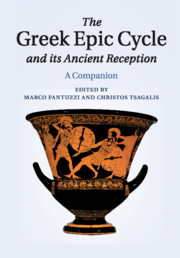Book contents
- Frontmatter
- Contents
- List of illustrations
- List of contributors
- Editorial note
- Introduction: Kyklos, the Epic Cycle and Cyclic poetry
- PART I APPROACHES TO THE EPIC CYCLE
- 1 Coming adrift: The limits of reconstruction of the cyclic poems
- 2 Oral traditions, written texts, and questions of authorship
- 3 The Epic Cycle and oral tradition
- 4 The formation of the Epic Cycle
- 5 Motif and source research: Neoanalysis, Homer, and Cyclic epic
- 6 Meta-Cyclic epic and Homeric poetry
- 7 Language and meter of the Epic Cycle
- 8 Narrative techniques in the Epic Cycle
- 9 Wit and irony in the Epic Cycle
- 10 The Trojan War in early Greek art
- PART II EPICS
- PART III THE FORTUNE OF THE EPIC CYCLE IN THE ANCIENT WORLD
- Works cited
- Index of principal passages
- Index nominum et rerum
10 - The Trojan War in early Greek art
from PART I - APPROACHES TO THE EPIC CYCLE
Published online by Cambridge University Press: 05 August 2015
- Frontmatter
- Contents
- List of illustrations
- List of contributors
- Editorial note
- Introduction: Kyklos, the Epic Cycle and Cyclic poetry
- PART I APPROACHES TO THE EPIC CYCLE
- 1 Coming adrift: The limits of reconstruction of the cyclic poems
- 2 Oral traditions, written texts, and questions of authorship
- 3 The Epic Cycle and oral tradition
- 4 The formation of the Epic Cycle
- 5 Motif and source research: Neoanalysis, Homer, and Cyclic epic
- 6 Meta-Cyclic epic and Homeric poetry
- 7 Language and meter of the Epic Cycle
- 8 Narrative techniques in the Epic Cycle
- 9 Wit and irony in the Epic Cycle
- 10 The Trojan War in early Greek art
- PART II EPICS
- PART III THE FORTUNE OF THE EPIC CYCLE IN THE ANCIENT WORLD
- Works cited
- Index of principal passages
- Index nominum et rerum
Summary
Images demonstrate unequivocally that by the middle of the seventh century BC the outline of the Trojan War, from the judgment of Paris to the Trojan horse and the sack of Troy, was known in many parts of the Greek world and beyond. Many episodes from that tradition appear on a variety of objects from the seventh century and early sixth century BC, mainly from the Peloponnese and the Aegean islands, while Athenian artisans seem to have had little interest in it until the 560s BC, after which Attic vases become our principal source of Trojan images. Most of the early images depict episodes we know from summaries of the poems of the Epic Cycle; very few of them refer to events from our Iliad and Odyssey.
To be comprehensible, most images of myth depend on prior knowledge of the event depicted, but from the images themselves it is rarely possible to determine precisely what the sources of that prior knowledge may have been. Archaic images can tell when and where a story was known but they cannot tell how it was known. Even when a text exists (e.g. Iliad), it is not possible to move confidently from an image to a text, much less so when all that survives are fragments of texts or summaries.
The question of whether or not an image reflects a specific text is primarily a modern one asked by students who are steeped in the textual traditions. The ancient viewers would obviously have known how they knew the stories behind the images, and on recognizing a scene, they would more likely have focused on its significance rather than on its source.
Given the small sample of archaic images that have come down to us, the fact that a story is not represented in surviving images does not necessarily tell us anything about the prevalence of that story. On the other hand, when a story is depicted, particularly when multiple examples exist, its appearance must indicate both the currency of the story in some form and the fact that it was significant for the artisans who created the images and usually for the patrons who obtained them.
- Type
- Chapter
- Information
- The Greek Epic Cycle and its Ancient ReceptionA Companion, pp. 178 - 196Publisher: Cambridge University PressPrint publication year: 2015
- 1
- Cited by



